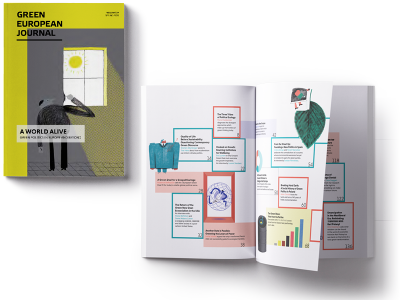The 2019 European elections saw Green parties achieve their best ever result. Their new weight in a fractured European Parliament is an opportunity for progress on climate, democracy and the rule of law, and social justice. Green parties often perform better at European elections but this time the success is sustained elsewhere. Local elections in the UK, national elections in Portugal, government coalitions in Finland, Sweden, and Luxembourg – the Greens are advancing at all levels. The major caveat is that the “green wave” is absent from much of southern and eastern Europe. Part of our latest edition looks at where political ecology made electoral gains, bringing together analyses of five Green parties to see where they are and to assess their prospects for the years to come. The first is journalist Peter Unfried’s analysis of the German Greens.
The German Greens were originally defined by guilt over the Holocaust and World War II, the social liberalisation of 1968, and the anti-nuclear movement. The party was characterised by “Green culture”, a minority attitude which assumed the mainstream to be culturally and morally inferior. Realpolitik was less important than being seen to be different. This imprinting meant that many important developments passed the Greens by – as in the case of German reunification or the development of a power-political European Union.
This changed decisively with the election of Winfried Kretschmann as prime minister of the Baden-Württemberg region in 2011. The fact that the Greens now had their first prime minister encouraged large sections of the party to move away from their usual “know it all” worldview.

This change in outlook did not reach the federal level until 2018, with the election of Annalena Baerbock and Robert Habeck as party chairs. They named their first country-wide summer tour “Unity and Justice and Freedom”, the title of the national anthem. In the past, state-sceptical Greens would have found this outrageous, but Habeck reinvented them as the defender of the res publica, its institutions, and the constitution.

Reinhard Bütikofer, MEP and long-standing chair of the European Greens, divides the party’s history into three phases. Phase one represented total opposition (“against”). In phase two, the party became somewhat constructive, entering into coalitions with the Social Democrats, but was seen as narrowly focused on the environment and gender (“for and against”). Now, phase three represents the attempt to become the leading force of a new, heterogeneous majority (“for”). The political backdrop is the failure of the former federal “people’s parties” to find an answer to the climate crisis, the rise of the Alternative für Deutschland (AfD), and the dwindling viability of the half-right, half-left politics of compromise to which the Federal Republic owes a good 70 years.
That the Greens will be part of the next government is clear to almost everyone, from German industry to Emmanuel Macron. The question is whether they will play a central role, and what they can achieve in Brussels with the help of the Scandinavian, Benelux, and above all the French governments on socio-environmental transformation, the defence of liberal democracy, and European prosperity and security. Their success in forming majorities in the European Parliament will be crucial. If the German European Greens stay stuck in the second phase and waver between progressive policies and a grotesque “it’d be nice if it were nicer” form of opposition, it could prove problematic. The “green wave” of the EU elections did not apply to the EU parliamentary group. It applied to Baerbock and Habeck alone.
This article is part of our latest edition, “A World Alive: Green Politics in Europe and Beyond”.

